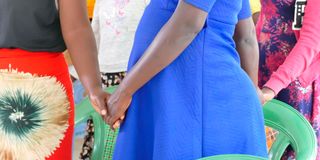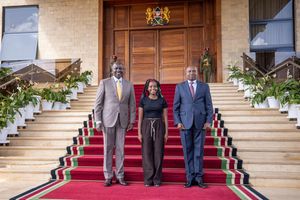No more secret fathers: Inside Homa Bay's revolutionary girls' protection web

A pregnant teenager - In Kochia Ward in Homa Bay County, administrators have devised a new strategy that could help weed out men who prey on school girls during holidays.
What you need to know:
- In a groundbreaking initiative to combat soaring teen pregnancy rates, Homa Bay County has deployed an invisible network of community watchers.
- The revolutionary surveillance system, which requires these trusted community members to secretly observe and report potential threats to local administrators, has dramatically reduced teen pregnancies.
- This community-led approach has transformed Homa Bay from a region where 31 percent of teenagers were mothers, to a model of child protection.
As the December sun sets over Homa Bay County, hundreds of children board buses and matatus, heading to their ancestral villages for the school holidays. It's a cherished tradition - urban children returning to their roots, connecting with grandparents, aunties, and uncles in the countryside. But in a county where 23.2 percent of teenagers are mothers, according to the Kenya Demographic Health Survey 2022, this seemingly innocent ritual masks a darker reality.
Behind the statistics lies a complex web of poverty, broken homes, and economic hardship. Girls who can't afford basic necessities like proper clothing and sanitary towels become easy targets for predators bearing gifts. The stigma surrounding menstruation compounds their vulnerability - those without sanitary products face mockery from peers, their self-esteem crumbling under the weight of shame.
"Sometimes the holidays become hunting seasons," says Judith Ojijo, the Assistant Chief of Lower Korayo, her voice carrying the weight of countless stories she's encountered. "What should be a time of family bonding too often turns into a nightmare for our teenage girls."
The scale of the crisis is staggering. According to the National Syndemic Disease Control Council, nearly half of all hospital deliveries in Nyanza region are to adolescents aged between 10 and 19. Many of these pregnancies, as the Council's chief executive officer Ruth Masha reported in an earlier interview, result from defilement by close family members or influential perpetrators.
In Ndhiwa, the situation is particularly dire. "In 2023 alone, 60 girls in one school fell pregnant by August," reveals David Ayieta, Ndhiwa's Director of Education. "Only 15 returned after giving birth, despite many being high performers in their final year." Each dropout represents a shattered dream, another link in the cycle of poverty.
But today, something remarkable is happening in this corner of Kenya. A silent revolution is underway, powered by an invisible network of community watchdogs who have vowed to protect their daughters.
In Kochia Ward, Lower Nyokal Division, a ground-breaking initiative is transforming how communities shield their children from sexual predators. The system is elegantly simple yet remarkably effective: two trusted community members - one man, one woman - assigned to monitor every ten households.
"My eyes and ears are always on the ground," Judith explains, leaning forward in her chair. "These observers are carefully chosen for their discretion. They're the kind who can keep secrets, who won't share sensitive information with friends over tea."
For many families in Homa Bay, sexual offences have traditionally been handled behind closed doors, especially in cases of incest.
"Families often settle these matters with livestock or money," Judith explains, "but our network is changing that culture of silence."
The transformation at Nyagoro Health Centre tells a powerful story of change. "We used to deliver babies to 35 teenagers every year," says Winnie Oluoch, the medical officer in charge. "Now? Just one." Her voice carries a hint of pride as she reveals how teenage deliveries have plummeted from 45 percent of all births to a mere fraction.
This dramatic reduction is particularly significant in a county that the National Council for Population and Development identified as having one of Kenya's highest teenage pregnancy rates, at over 31 percent. The success of Kochia Ward's initiative offers hope that similar community-led approaches could transform other hotspots across the region.
But the revolution doesn't stop at surveillance. Across Homa Bay, a comprehensive support system is taking shape.
At Nyagoro and Nyalkinyi hospitals, 'safe spaces' have been created where young people can access reproductive health services without judgment. Young medical professionals, fluent in youth slang and culture, staff these centres, ensuring teenagers feel understood and respected.
"We have put suggestion boxes around the health facility where youths can give views on some of the services they want," Oluoch explains. "They can also offer suggestions for improvements or lodge complaints."
At Nyalkinyi Hospital, the approach is equally innovative. Lucas Okeyo, the head medical officer, oversees a team of community health promoters (CHPs) trained to use self-test kits for HIV monitoring among youth.
"They also have referral documents which they use to refer clients to the hospital," he says, adding that the facility offers free contraceptive services.
The initiative, supported by the Network for Adolescent and Youth for Africa (Naya), takes aim at what they call the "triple threat" - gender-based violence, teen pregnancies, and new HIV infections. It's a battle fought on multiple fronts, from community health promoters conducting HIV tests in high-risk areas to paralegals offering legal support to survivors of violence.
The system has teeth. Judith’s office has instituted a rule requiring all teenage mothers seeking birth certificates for their children to reveal the identity of the fathers. It's a bold move aimed at deterring predatory relationships, especially those involving relatives.
Naya Representative Emaculate Oliech emphasises that working with community members is crucial in addressing the triple threat. Her organisation implements similar programs in Malela in Ndhiwa and Miniambo in Homa Bay Town, relying on peer educators to teach youth about self-care and protection.
Sometimes, reaching young people requires creativity. Nicholas Ouso, the Lower Korayo Community Health Promoter officer, describes how they organise sports tournaments in collaboration with the Ministry of Interior to engage youth.
"When traditional meetings don't work, we meet them where they are," he says with a smile.
For youth advocate Meline Adhiambo, the work goes beyond surveillance. She understands how poverty makes girls vulnerable to exploitation.
"Many of my peers avoid hospitals, fearing judgment," she says. "But we're showing them there's support available, that they don't have to face these challenges alone."
As the sun rises over Homa Bay each morning, this invisible army of protectors takes their positions. They're not wearing uniforms or carrying badges, but their impact is unmistakable. In every village, every neighbourhood, they're sending a clear message to would-be predators: our children are no longer easy prey.
The transformation of Homa Bay from a hotspot of teenage pregnancies to a model of community protection hasn't just changed statistics - it's changing lives. One careful observation, one prevented assault, one protected child at a time, and they are weaving a safer future for Kenya's daughters.
For the children boarding those holiday buses today, the journey home is becoming what it always should have been - a time of joy, connection, and safety, protected by the watchful eyes of a community that refuses to look away.



